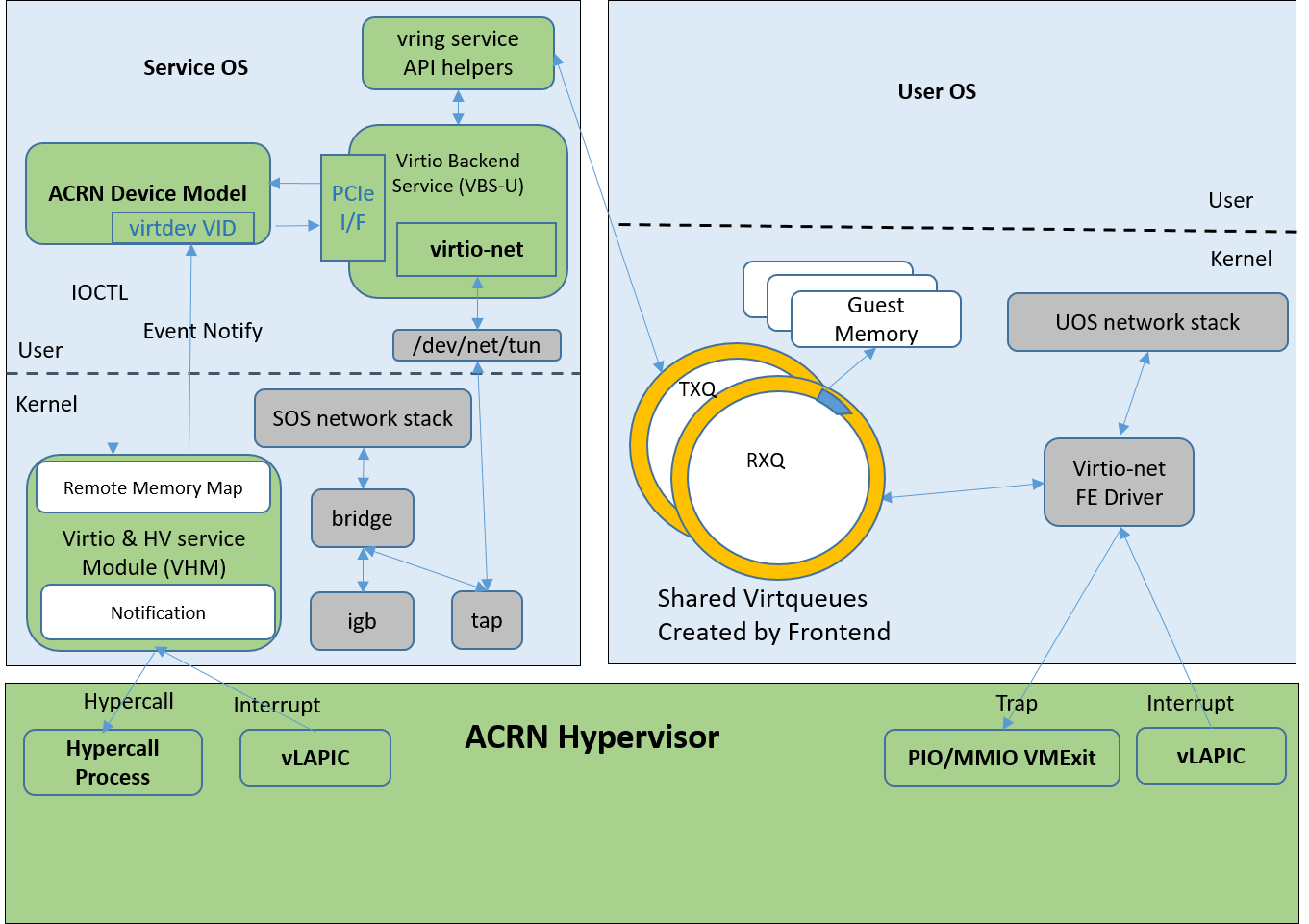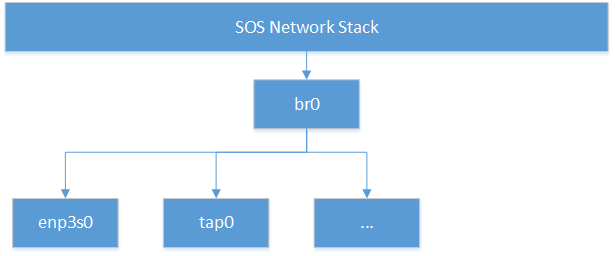Virtio-net¶
Virtio-net is the para-virtualization solution used in ACRN for networking. The ACRN device model emulates virtual NICs for UOS and the frontend virtio network driver, simulating the virtual NIC and following the virtio specification. (Refer to Introduction to Project ACRN and Virtio devices high-level design background introductions to ACRN and Virtio.)
Here are some notes about Virtio-net support in ACRN:
- Legacy devices are supported, modern devices are not supported
- Two virtqueues are used in virtio-net: RX queue and TX queue
- Indirect descriptor is supported
- TAP backend is supported
- Control queue is not supported
- NIC multiple queues are not supported
Network Virtualization Architecture¶
ACRN’s network virtualization architecture is shown below in Figure 127, and illustrates the many necessary network virtualization components that must cooperate for the UOS to send and receive data from the outside world.
(The green components are parts of the ACRN solution, while the gray components are parts of the Linux kernel.)
Let’s explore these components further.
- SOS/UOS Network Stack:
- This is the standard Linux TCP/IP stack, currently the most feature-rich TCP/IP implementation.
- virtio-net Frontend Driver:
- This is the standard driver in the Linux Kernel for virtual Ethernet devices. This driver matches devices with PCI vendor ID 0x1AF4 and PCI Device ID 0x1000 (for legacy devices in our case) or 0x1041 (for modern devices). The virtual NIC supports two virtqueues, one for transmitting packets and the other for receiving packets. The frontend driver places empty buffers into one virtqueue for receiving packets, and enqueues outgoing packets into another virtqueue for transmission. The size of each virtqueue is 1024, configurable in the virtio-net backend driver.
- ACRN Hypervisor:
- The ACRN hypervisor is a type 1 hypervisor, running directly on the bare-metal hardware, and suitable for a variety of IoT and embedded device solutions. It fetches and analyzes the guest instructions, puts the decoded information into the shared page as an IOREQ, and notifies or interrupts the VHM module in the SOS for processing.
- VHM Module:
- The Virtio and Hypervisor Service Module (VHM) is a kernel module in the Service OS (SOS) acting as a middle layer to support the device model and hypervisor. The VHM forwards a IOREQ to the virtio-net backend driver for processing.
- ACRN Device Model and virtio-net Backend Driver:
- The ACRN Device Model (DM) gets an IOREQ from a shared page and calls the virtio-net backend driver to process the request. The backend driver receives the data in a shared virtqueue and sends it to the TAP device.
- Bridge and Tap Device:
- Bridge and Tap are standard virtual network infrastructures. They play an important role in communication among the SOS, the UOS, and the outside world.
- IGB Driver:
- IGB is the physical Network Interface Card (NIC) Linux kernel driver responsible for sending data to and receiving data from the physical NIC.
The virtual network card (NIC) is implemented as a virtio legacy device
in the ACRN device model (DM). It is registered as a PCI virtio device
to the guest OS (UOS) and uses the standard virtio-net in the Linux kernel as
its driver (the guest kernel should be built with
CONFIG_VIRTIO_NET=y).
The virtio-net backend in DM forwards the data received from the frontend to the TAP device, then from the TAP device to the bridge, and finally from the bridge to the physical NIC driver, and vice versa for returning data from the NIC to the frontend.
ACRN Virtio-Network Calling Stack¶
Various components of ACRN network virtualization are shown in the architecture diagram shows in Figure 127. In this section, we will use UOS data transmission (TX) and reception (RX) examples to explain step-by-step how these components work together to implement ACRN network virtualization.
Initialization in Device Model¶
virtio_net_init
- Present frontend for a virtual PCI based NIC
- Setup control plan callbacks
- Setup data plan callbacks, including TX, RX
- Setup tap backend
Initialization in virtio-net Frontend Driver¶
virtio_pci_probe
- Construct virtio device using virtual pci device and register it to virtio bus
virtio_dev_probe –> virtnet_probe –> init_vqs
- Register network driver
- Setup shared virtqueues
ACRN UOS TX FLOW¶
The following shows the ACRN UOS network TX flow, using TCP as an example, showing the flow through each layer:
UOS TCP Layer
tcp_sendmsg -->
tcp_sendmsg_locked -->
tcp_push_one -->
tcp_write_xmit -->
tcp_transmit_skb -->
UOS IP Layer
ip_queue_xmit -->
ip_local_out -->
__ip_local_out -->
dst_output -->
ip_output -->
ip_finish_output -->
ip_finish_output2 -->
neigh_output -->
neigh_resolve_output -->
UOS MAC Layer
dev_queue_xmit -->
__dev_queue_xmit -->
dev_hard_start_xmit -->
xmit_one -->
netdev_start_xmit -->
__netdev_start_xmit -->
UOS MAC Layer virtio-net Frontend Driver
start_xmit --> // virtual NIC driver xmit in virtio_net
xmit_skb -->
virtqueue_add_outbuf --> // add out buffer to shared virtqueue
virtqueue_add -->
virtqueue_kick --> // notify the backend
virtqueue_notify -->
vp_notify -->
iowrite16 --> // trap here, HV will first get notified
ACRN Hypervisor
vmexit_handler --> // vmexit because VMX_EXIT_REASON_IO_INSTRUCTION
pio_instr_vmexit_handler -->
emulate_io --> // ioreq cant be processed in HV, forward it to VHM
acrn_insert_request_wait -->
fire_vhm_interrupt --> // interrupt SOS, VHM will get notified
VHM Module
vhm_intr_handler --> // VHM interrupt handler
tasklet_schedule -->
io_req_tasklet -->
acrn_ioreq_distribute_request --> // ioreq can't be processed in VHM, forward it to device DM
acrn_ioreq_notify_client -->
wake_up_interruptible --> // wake up DM to handle ioreq
ACRN Device Model / virtio-net Backend Driver
handle_vmexit -->
vmexit_inout -->
emulate_inout -->
pci_emul_io_handler -->
virtio_pci_write -->
virtio_pci_legacy_write -->
virtio_net_ping_txq --> // start TX thread to process, notify thread return
virtio_net_tx_thread --> // this is TX thread
virtio_net_proctx --> // call corresponding backend (tap) to process
virtio_net_tap_tx -->
writev --> // write data to tap device
SOS TAP Device Forwarding
do_writev -->
vfs_writev -->
do_iter_write -->
do_iter_readv_writev -->
call_write_iter -->
tun_chr_write_iter -->
tun_get_user -->
netif_receive_skb -->
netif_receive_skb_internal -->
__netif_receive_skb -->
__netif_receive_skb_core -->
SOS Bridge Forwarding
br_handle_frame -->
br_handle_frame_finish -->
br_forward -->
__br_forward -->
br_forward_finish -->
br_dev_queue_push_xmit -->
SOS MAC Layer
dev_queue_xmit -->
__dev_queue_xmit -->
dev_hard_start_xmit -->
xmit_one -->
netdev_start_xmit -->
__netdev_start_xmit -->
SOS MAC Layer IGB Driver
igb_xmit_frame --> // IGB physical NIC driver xmit function
ACRN UOS RX FLOW¶
The following shows the ACRN UOS network RX flow, using TCP as an example. Let’s start by receiving a device interrupt. (Note that the hypervisor will first get notified when receiving an interrupt even in passthrough cases.)
Hypervisor Interrupt Dispatch
vmexit_handler --> // vmexit because VMX_EXIT_REASON_EXTERNAL_INTERRUPT
external_interrupt_vmexit_handler -->
dispatch_interrupt -->
common_handler_edge -->
ptdev_interrupt_handler -->
ptdev_enqueue_softirq --> // Interrupt will be delivered in bottom-half softirq
Hypervisor Interrupt Injection
do_softirq -->
ptdev_softirq -->
vlapic_intr_msi --> // insert the interrupt into SOS
start_vcpu --> // VM Entry here, will process the pending interrupts
SOS MAC Layer IGB Driver
do_IRQ -->
...
igb_msix_ring -->
igbpoll -->
napi_gro_receive -->
napi_skb_finish -->
netif_receive_skb_internal -->
__netif_receive_skb -->
__netif_receive_skb_core --
SOS Bridge Forwarding
br_handle_frame -->
br_handle_frame_finish -->
br_forward -->
__br_forward -->
br_forward_finish -->
br_dev_queue_push_xmit -->
SOS MAC Layer
dev_queue_xmit -->
__dev_queue_xmit -->
dev_hard_start_xmit -->
xmit_one -->
netdev_start_xmit -->
__netdev_start_xmit -->
SOS MAC Layer TAP Driver
tun_net_xmit --> // Notify and wake up reader process
ACRN Device Model / virtio-net Backend Driver
virtio_net_rx_callback --> // the tap fd get notified and this function invoked
virtio_net_tap_rx --> // read data from tap, prepare virtqueue, insert interrupt into the UOS
vq_endchains -->
vq_interrupt -->
pci_generate_msi -->
VHM Module
vhm_dev_ioctl --> // process the IOCTL and call hypercall to inject interrupt
hcall_inject_msi -->
ACRN Hypervisor
vmexit_handler --> // vmexit because VMX_EXIT_REASON_VMCALL
vmcall_vmexit_handler -->
hcall_inject_msi --> // insert interrupt into UOS
vlapic_intr_msi -->
UOS MAC Layer virtio_net Frontend Driver
vring_interrupt --> // virtio-net frontend driver interrupt handler
skb_recv_done --> //registed by virtnet_probe-->init_vqs-->virtnet_find_vqs
virtqueue_napi_schedule -->
__napi_schedule -->
virtnet_poll -->
virtnet_receive -->
receive_buf -->
UOS MAC Layer
napi_gro_receive -->
napi_skb_finish -->
netif_receive_skb_internal -->
__netif_receive_skb -->
__netif_receive_skb_core -->
UOS IP Layer
ip_rcv -->
ip_rcv_finish -->
dst_input -->
ip_local_deliver -->
ip_local_deliver_finish -->
UOS TCP Layer
tcp_v4_rcv -->
tcp_v4_do_rcv -->
tcp_rcv_established -->
tcp_data_queue -->
tcp_queue_rcv -->
__skb_queue_tail -->
sk->sk_data_ready --> // application will get notified
How to Use¶
The network infrastructure shown in Figure 128 needs to be prepared in the SOS before we start. We need to create a bridge and at least one tap device (two tap devices are needed to create a dual virtual NIC) and attach a physical NIC and tap device to the bridge.
You can use Linux commands (e.g. ip, brctl) to create this network. In
our case, we use systemd to automatically create the network by default.
You can check the files with prefix 50- in the SOS
/usr/lib/systemd/network/:
When the SOS is started, run ifconfig to show the devices created by
this systemd configuration:
acrn-br0 Link encap:Ethernet HWaddr B2:50:41:FE:F7:A3
inet addr:10.239.154.43 Bcast:10.239.154.255 Mask:255.255.255.0
inet6 addr: fe80::b050:41ff:fefe:f7a3/64 Scope:Link
UP BROADCAST RUNNING MULTICAST MTU:1500 Metric:1
RX packets:226932 errors:0 dropped:21383 overruns:0 frame:0
TX packets:14816 errors:0 dropped:0 overruns:0 carrier:0
collisions:0 txqueuelen:1000
RX bytes:100457754 (95.8 Mb) TX bytes:83481244 (79.6 Mb)
acrn_tap0 Link encap:Ethernet HWaddr F6:A7:7E:52:50:C6
UP BROADCAST MULTICAST MTU:1500 Metric:1
RX packets:0 errors:0 dropped:0 overruns:0 frame:0
TX packets:0 errors:0 dropped:0 overruns:0 carrier:0
collisions:0 txqueuelen:1000
RX bytes:0 (0.0 b) TX bytes:0 (0.0 b)
enp3s0 Link encap:Ethernet HWaddr 98:4F:EE:14:5B:74
inet6 addr: fe80::9a4f:eeff:fe14:5b74/64 Scope:Link
UP BROADCAST RUNNING MULTICAST MTU:1500 Metric:1
RX packets:279174 errors:0 dropped:0 overruns:0 frame:0
TX packets:69923 errors:0 dropped:0 overruns:0 carrier:0
collisions:0 txqueuelen:1000
RX bytes:107312294 (102.3 Mb) TX bytes:87117507 (83.0 Mb)
Memory:82200000-8227ffff
lo Link encap:Local Loopback
inet addr:127.0.0.1 Mask:255.0.0.0
inet6 addr: ::1/128 Scope:Host
UP LOOPBACK RUNNING MTU:65536 Metric:1
RX packets:16 errors:0 dropped:0 overruns:0 frame:0
TX packets:16 errors:0 dropped:0 overruns:0 carrier:0
collisions:0 txqueuelen:1000
RX bytes:1216 (1.1 Kb) TX bytes:1216 (1.1 Kb)
Run brctl show to see the bridge acrn-br0 and attached devices:
bridge name bridge id STP enabled interfaces
acrn-br0 8000.b25041fef7a3 no acrn_tap0
enp3s0
Add a pci slot to the device model acrn-dm command line (mac address is optional):
-s 4,virtio-net,<tap_name>,[mac=<XX:XX:XX:XX:XX:XX>]
When the UOS is launched, run ifconfig to check the network. enp0s4r
is the virtual NIC created by acrn-dm:
enp0s4 Link encap:Ethernet HWaddr 00:16:3E:39:0F:CD
inet addr:10.239.154.186 Bcast:10.239.154.255 Mask:255.255.255.0
inet6 addr: fe80::216:3eff:fe39:fcd/64 Scope:Link
UP BROADCAST RUNNING MULTICAST MTU:1500 Metric:1
RX packets:140 errors:0 dropped:8 overruns:0 frame:0
TX packets:46 errors:0 dropped:0 overruns:0 carrier:0
collisions:0 txqueuelen:1000
RX bytes:110727 (108.1 Kb) TX bytes:4474 (4.3 Kb)
lo Link encap:Local Loopback
inet addr:127.0.0.1 Mask:255.0.0.0
inet6 addr: ::1/128 Scope:Host
UP LOOPBACK RUNNING MTU:65536 Metric:1
RX packets:0 errors:0 dropped:0 overruns:0 frame:0
TX packets:0 errors:0 dropped:0 overruns:0 carrier:0
collisions:0 txqueuelen:1000
RX bytes:0 (0.0 b) TX bytes:0 (0.0 b)
Performance Estimation¶
We’ve introduced the network virtualization solution in ACRN, from the top level architecture to the detailed TX and RX flow. Currently, the control plane and data plane are all processed in ACRN device model, which may bring some overhead. But this is not a bottleneck for 1000Mbit NICs or below. Network bandwidth for virtualization can be very close to the native bandwidth. For high speed NIC (e.g. 10Gb or above), it is necessary to separate the data plane from the control plane. We can use vhost for acceleration. For most IoT scenarios, processing in user space is simple and reasonable.

